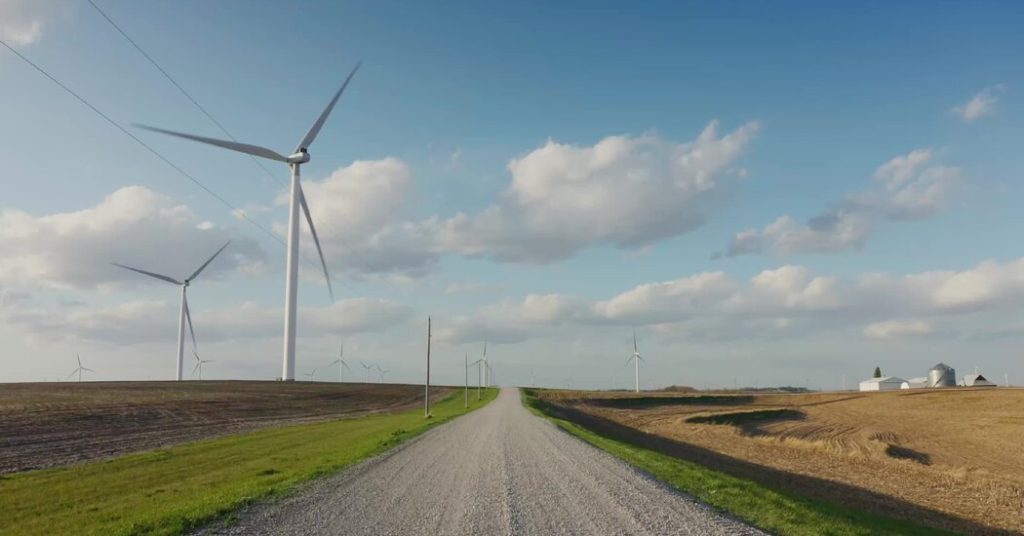Eric Chamberlain was at work, driving a hearse, when he first caught sight of the wind turbine that would set him on a path to change the fortunes of his hometown.
It was the mid-2000s, and Mr. Chamberlain was leading a funeral procession in Iowa, across the border from his home in Atchison County in northwest Missouri, when giant white blades came into view. Mr. Chamberlain had heard of wind energy but not seen a commercial turbine before. He was intrigued, but obviously couldn’t pull over to take a closer look.
“I didn’t stop,” said Mr. Chamberlain, whose family has operated Chamberlain Funeral Homes and Monuments since 1968. “I was polite.”
After the funeral, he visited a local newspaper in Iowa to ask people there about the wind energy project.
Mr. Chamberlain, 70, grew up in Atchison, one of Missouri’s most rural counties, and over the years watched as waning opportunities and population decline steadily ate away at the place. Young people didn’t come back after college. School enrollment fell. Farms got bigger, and fewer farmers meant less tax revenue. Businesses on Main Street closed and the area went from having two grocery stores to one.
50 States, 50 Fixes is a series about local solutions to environmental problems. More to come this year.
One thing the county did have was lots of wind, and Mr. Chamberlain thought that having a few commercial turbines might bring an economic boost. He contacted the state’s Department of Natural Resources about putting up a wind monitoring tower on the hilltop of a nearby pasture. The paper, The Atchison County Mail, announced this endeavor under the headline, “Chamberlain to Study Wind,” drawing mirth as well as the attention of a wind power developer from St. Louis.
The developer came to Atchison County, and Mr. Chamberlain drove him and some engineers around to prospective sites, in the van he also used to drive around pallbearers. He also connected the group with local landowners, laying the groundwork for the county’s first wind farm.
Mr. Chamberlain ended up becoming a local consultant on the project, and, as it was being developed, thought it would be a good idea to also set up a small community wind project to help power the county seat, Rock Port. The small city bought power from a municipal power pool, but also had its own power plant that could supply electricity during outages.
Mr. Chamberlain convinced the wind farm’s developer, as well as Rock Port’s City Council and utility board, that installing several wind turbines to directly feed the city’s power system would be economically advantageous for all involved.
“I won’t deny that there were environmental benefits that I believed in,” Mr. Chamberlain said. “Unfortunately, I also believe that it would have been a harder sell if that was the only talking point.”
The project was paid for by John Deere’s former wind energy division, and three landowners allowed turbines on their property. The four turbines came online in early 2008, producing 5 megawatts of energy for a city that, according to Mr. Chamberlain, used 3.5 megawatts, tops. That day, Mr. Chamberlain took a picture of the city’s electricity meter. “It was running backward,” he said. Rock Port, population around 1,300, eventually announced that it was the first community in the country to produce more electricity from wind energy than the town needed.
Rebecca Herron, whose late mother was one of the first landowners to accept a turbine, heartily applauded the move.
“I was very thrilled because I thought it was time that we produce our electricity in this country, instead of relying on all the foreign stuff,” said Ms Herron, 78, a retired farmer. Two turbines are on the family’s pastureland, sharing space with cattle, and the family collects rent payments once a year. “That was good, to have extra money, and it helps the city and the community,” Ms. Herron said. “I’m very happy with it.”
Today, Atchison County is home to 342 wind turbines that support about 50 permanent jobs, along with a wind technician training facility and yearly landowner lease payments of several million dollars, Mr. Chamberlain said. According to the Atchison clerk’s office, the county collected $5.9 million from taxes from wind turbines in 2024, accounting for more than half of its real estate tax revenue. The city utility also doesn’t have to pay transmission line fees on the energy it uses from the wind farm, Mr. Chamberlain added, saving around $50,000 a year.
Mr. Chamberlain now drives around a pickup truck that bears the license plate “WND CZR.”
“I’m proud of what got started here, it literally changed the economy of the county,” Mr. Chamberlain said. “We’re always going to be rural and farming and agricultural-based, and this is quite an addition. I can’t think of anything else that would add $5 million in property taxes to our county without detracting from our base.”


